|
| A |
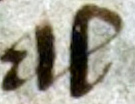 | Usage: al
the scribe's double compartment 'a's are consistently formed with flat hairline head-stroke and thick down-stroke to the right which are sometimes gently curved at head and foot. |  | Usage: and
the upper compartment is sometimes very angular, appearing as a triangle. |
| Usage: And
one of the scribe's upper case 'A's with freely waving head- stroke. | 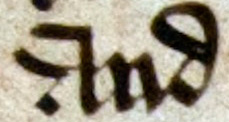 | Usage: And
the head-stroke and down-stroke form a right angle. The curving stroke which forms the lower part of the upper compartment is not always attached. The lower compartment is formed as a rectangle with two hairline strokes joined by a thick stroke set at an angle. |
|
| D |
 | Usage: derly
'd' is consistently formed with an angular lower lobe and a more rounded loop above. | 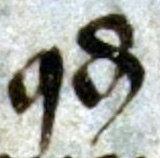 | Usage: qd
in the 'quod' abbreviation, the down-stroke of the loop is continued to curve down beneath the graph. |
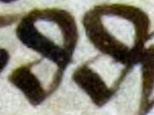 | Usage: myddys | 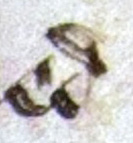 | Usage: dremed
'd' in final position with triangular lobe and a waisted appearance as loop meets lobe. Several other 'd's in final position in a line may have a tag as seen on the 'd' in 'quod', but it is difficult to be certain because they disappear into the gutter. |
|
| G |
 | Usage: grace
there are very few examples of 'g' on this folio. Each example is a double compartment graph. |  | Usage: kyng
an example of 'g' in final position. |
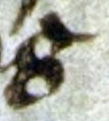 | Usage: kyng
another final 'g' from the second use of 'kyng'. | 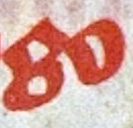 | Usage: Ergo
use of 'g' in a Latin word. |
|
| H |
 | Usage: his
'h' in initial position. The stem is generally upright with rounded head-stroke which grazes the top of the shoulder. | 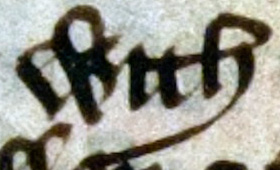 | Usage: with
the tail of 'h' frequently extends in a sweep beneath an entire word. |
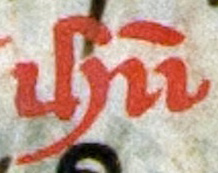 | Usage: ihu | 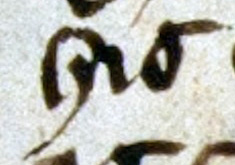 | Usage: His
upper case 'H' at the beginning of a line. It is exactly the same as the lower case version. |
|
| R |
 | Usage: riȝt
modern 'r' used throughout except after 'o' and a few other round-bodied graphs. |  | Usage: Patriarkes
the second 'r' in this example has degenerated to become a 'v'-like graph. |
 | Usage: for
'z'-shaped 'r' is casually formed. |  | Usage: Resoun
the upper-case version of the graph. |
|
| S |
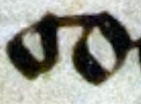 | Usage: solaced
sigma 's' used in initial and final positions. Long 's' used as an initial letter very occasionally. |  | Usage: cros
sigma 's' in final position. |
 | Usage: hardinesse
long 's' is used invariably within a word. |  | Usage: armes
this word is at the end of a line. The final sigma 's' has a longer than usual extension into the right margin. |
|
| W |
 | Usage: with
'w' is fairly uniform and usually has a straight left limb with the middle loop standing above the level of first and final elements. |  | Usage: þow |
 | Usage: knowen
a variant 'w' in the middle of a word. The left limb is not the usual straight line. |  | Usage: Whi
upper case 'W' at the beginning of a line does not vary from the lower case version. |
|
| Y |
 | Usage: hym
the left limb is usually a tapering stroke running vertically to the lower level of the graphs where the sloping second stroke creates the fork. |  | Usage: day
'y' in final position and a longer than usual tail which descends at an angle before turning counter-clockwise. |
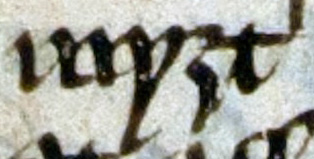 | Usage: myȝt
a very curtailed tail-stroke in this example. |  | Usage: sodeynly
two examples of 'y' in this word. The long tails tangle with the words on the line below. |
|
| Thorn and Yogh |
 | Usage: þe
thorn is used regularly for the definite article, adjectives and pronouns. It is used occasionally as a replacement 'th' as in the word 'worþi'. |  | Usage: Þow
a thorn at the beginning of a line. |
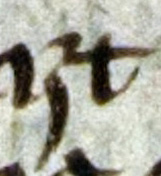 | Usage: kniȝt
yogh is always used as representing 'gh'. |  | Usage: plouȝman |
|
| Upper Case Letters |
 | Usage: To
upper case 'T' with unusual diagonal hairline within and a half stroke descending from the middle of it into the 'V'-shape formed by the curve of the stem. |  | Usage: Patriarkes
upper case 'P' with the head of a blue paragraph mark crossing through the graph. |
 | Usage: Is
upper case 'I' which is variously formed. |  | Usage: Bot
a distinctive upper case 'B'. |









































